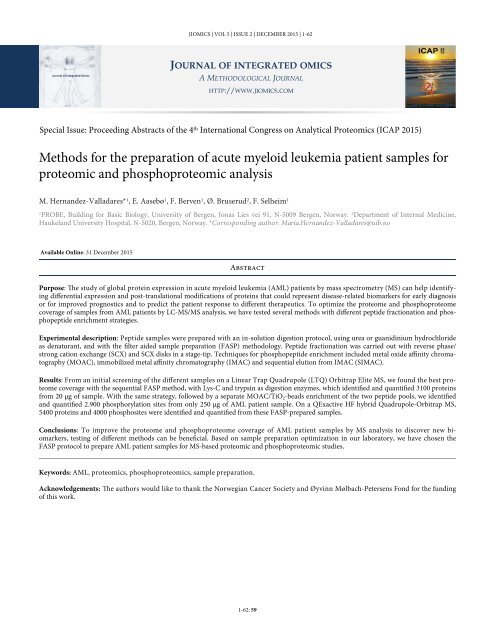JIOMICS
JIOMICS Internacional
JIOMICS Internacional
You also want an ePaper? Increase the reach of your titles
YUMPU automatically turns print PDFs into web optimized ePapers that Google loves.
<strong>JIOMICS</strong> | VOL 5 | ISSUE 2 | DECEMBER 2015 | 1-62<br />
JOURNAL OF INTEGRATED OMICS<br />
Journal of Integrated Omics<br />
A METHODOLOGICAL JOURNAL<br />
HTTP://WWW.<strong>JIOMICS</strong>.COM<br />
Special Issue: Proceeding Abstracts of the 4 th International Congress on Analytical Proteomics (ICAP 2015)<br />
Methods for the preparation of acute myeloid leukemia patient samples for<br />
proteomic and phosphoproteomic analysis<br />
M. Hernandez-Valladares* 1 , E. Aasebø 1 , F. Berven 1 , Ø. Bruserud 2 , F. Selheim 1<br />
1<br />
PROBE, Building for Basic Biology, University of Bergen, Jonas Lies vei 91, N-5009 Bergen, Norway. 2 Department of Internal Medicine,<br />
Haukeland University Hospital, N-5020, Bergen, Norway. *Corresponding author: Maria.Hernandez-Valladares@uib.no<br />
Available Online: 31 December 2015<br />
Abstract<br />
Purpose: The study of global protein expression in acute myeloid leukemia (AML) patients by mass spectrometry (MS) can help identifying<br />
differential expression and post-translational modifications of proteins that could represent disease-related biomarkers for early diagnosis<br />
or for improved prognostics and to predict the patient response to different therapeutics. To optimize the proteome and phosphoproteome<br />
coverage of samples from AML patients by LC-MS/MS analysis, we have tested several methods with different peptide fractionation and phosphopeptide<br />
enrichment strategies.<br />
Experimental description: Peptide samples were prepared with an in-solution digestion protocol, using urea or guanidinium hydrochloride<br />
as denaturant, and with the filter aided sample preparation (FASP) methodology. Peptide fractionation was carried out with reverse phase/<br />
strong cation exchange (SCX) and SCX disks in a stage-tip. Techniques for phosphopeptide enrichment included metal oxide affinity chromatography<br />
(MOAC), immobilized metal affinity chromatography (IMAC) and sequential elution from IMAC (SIMAC).<br />
Results: From an initial screening of the different samples on a Linear Trap Quadrupole (LTQ) Orbitrap Elite MS, we found the best proteome<br />
coverage with the sequential FASP method, with Lys-C and trypsin as digestion enzymes, which identified and quantified 3100 proteins<br />
from 20 μg of sample. With the same strategy, followed by a separate MOAC/TiO 2 -beads enrichment of the two peptide pools, we identified<br />
and quantified 2.900 phosphorylation sites from only 250 μg of AML patient sample. On a QExactive HF hybrid Quadrupole-Orbitrap MS,<br />
5400 proteins and 4000 phosphosites were identified and quantified from these FASP-prepared samples.<br />
Conclusions: To improve the proteome and phosphoproteome coverage of AML patient samples by MS analysis to discover new biomarkers,<br />
testing of different methods can be beneficial. Based on sample preparation optimization in our laboratory, we have chosen the<br />
FASP protocol to prepare AML patient samples for MS-based proteomic and phosphoproteomic studies.<br />
Keywords: AML, proteomics, phosphoproteomics, sample preparation.<br />
Acknowledgements: The authors would like to thank the Norwegian Cancer Society and Øyvinn Mølbach-Petersens Fond for the funding<br />
of this work.<br />
1-62: 59


